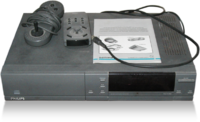From NintendoWiki, your source on Nintendo information. By fans, for fans.
Philips CD-i
|
|
|
| No. of games
|
|
| No. of launch titles
|
{{{launch_games}}}
|
| Best-selling game
|
{{{best_games}}}
|
| Last game
|
|
|
|
| Media
|
CD-i disc
|
| Storage capacity
|
1 MB RAM
|
| CPU
|
Philips SCC68070
|
| Model no.
|
{{{model}}}
|
|
| Can connect with
|
N/A
|
| Input
|
{{{input}}}
|
| Backwards compatible with
|
N/A
|
| Services provided
|
Multimedia player
|
|
| Launch date
|
- NA: December 3, 1991
- EU: 1992
|
| Discontinue date
|
1998
|
| Units sold
|
1 million
|
|
|
|
The Philips CD-i is a home multimedia device released in 1991 by Philips. Acting in some ways similar to a modern-day DVD player, the CD-i was supposed to represent a revolutionary new era for media players - a single device that could play not just music CDs but also video games.
The CD-i was the result of a failed deal between Nintendo and Sony to create a CD-based add-on for the SNES called the PlayStation Experimental. Sony, however, wanted a large share of the profit from this add-on, as well as the right to brand it with their logo. Without warning, Nintendo canceled the deal, moving to Sony's rival Philips to make the same add-on. Sony's research and development on the PlayStation Experimental led to the release of the PlayStation console in 1994 as a rival to the Sega Saturn and the Nintendo 64 in 1996.
When Nintendo eventually backed out of the deal with Philips, Philips demanded to use several of Nintendo's characters in games for the CD-i, leading to the notoriously poor Zelda: The Wand of Gamelon, Link: The Faces of Evil, Zelda's Adventure, and Hotel Mario.
Models
The Philips CD-i was released in a number of models by Phillips depending on the market:
- CD-i player 200 series: includes the CD-i 205, 210, and 220 models, marketed toward the general public.
- CD-i player 300 series: includes the CD-i 310, 350, 360, and 370 models, marketed for professional use.
- CD-i player 400 series: includes the CD-i 450, 470, and 490 models, slimmed-down units marketed toward the console and educational markets.
- CD-i player 900 series: includes the CD-i 601, 602, 604, 605, 615, 660, and 670 models, marketed toward professional software developers, not made available for the general market.
External links

|
This article is a stub. You can help NintendoWiki by expanding it.
|
|
|
|
|
|
|
| Other
|
| Standalone consoles
|
Arcade
|
Pokémon
|
Classics
|
Cancelled
|
|
|
|
|
|
|
|


